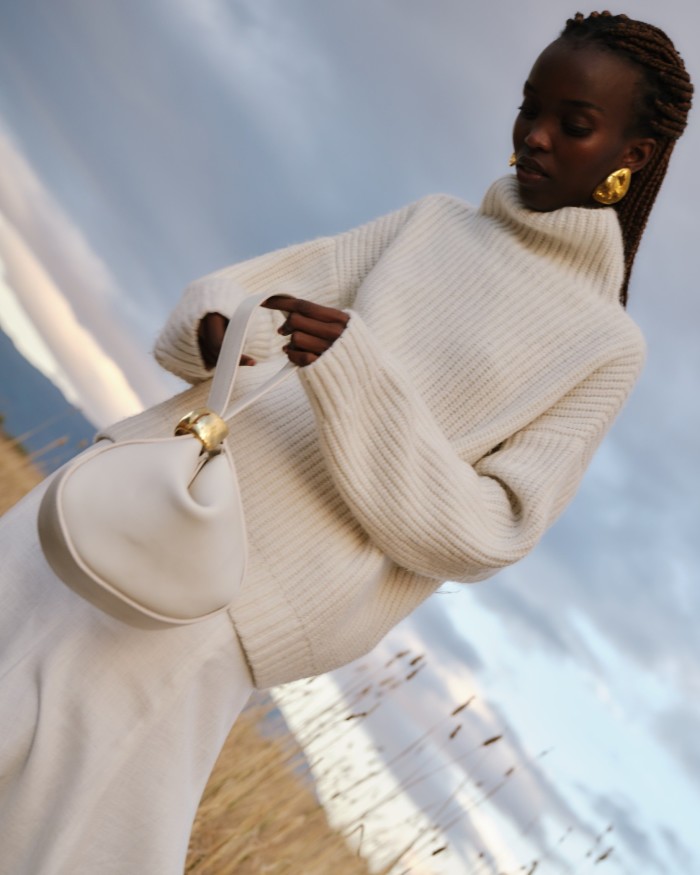how summer brands adapt for winter

Not long ago, Anita Patrickson found herself in an unusual situation. The minimalist sandals Patrickson designed for Amanu Studio, her six-year-old footwear brand, were popular on Moda Operandi and Net-a-Porter, but buyers kept requesting belts — a product she’d never offered. “They’d come into the studio, see the rolls of leather we had on display and say, ‘Can’t you just make me a belt?’” says Patrickson, a red-carpet stylist for celebrities including Emma Watson and Eiza González before she shifted her focus to Amanu.
She initially declined — belts being “this whole different thing” — but continued to mull it over and realised that products beyond sandals would add dimension to the brand, and offer a path to keeping workers at Amanu’s Cape Town factory employed year-round. “We’re very seasonal and we wanted something that would level that out.”
That led to the launch of Amanu’s leather belts and handbags in August. Patrickson expected the first run of leather bags with sculptural brass handles to last the whole season. It sold out in 13 days. “What’s been really lovely is just being able to see it all together,” says Patrickson, who’s currently awaiting a restock of all belt and bag styles. “It suddenly feels like a complete brand.”
When brands find success around season-specific products, it can be tempting for founders to stick to a winning formula. But increasingly, labels closely aligned with a particular season are seeking to diversify and enhance their year-round appeal.

Summer-centric brands Mondo Corsini and Faune recently launched autumn/winter collections consisting of their typical dresses, but in more winter-suited fabric. So did Ancient Greek Sandals: in place of summer’s strappy leather sandals and jelly flats are sheepskin-lined sliders and clogs, with jewel-toned satin slippers to follow closer to holiday season. La DoubleJ’s dolce-vita dresses were the jumping-off point for its up-tempo autumn/winter collections and homeware, ski specialist Perfect Moment has since moved into swimwear and Zimmermann turned its breezy resortwear sensibility into the foundation of a lifestyle brand, offering everything from bikinis to kidswear.


“To grow and evolve as a business, you can’t just have one collection,” says Mondo Corsini founder Susan Corsini. “When you’re that seasonal, there are so many down months that you can’t afford to build a team or develop any interesting structure around the business. So from a business perspective, we needed to do more [and] have relevant product throughout the year.”
Her first autumn-winter collection, a concise range of heavier-weight cotton blouses, drill trousers and quilted silk-velvet jackets, went online earlier this month. Because sometimes the women who buy her airy linen dresses for summer holidays to Sardinia need to layer up and keep warm, too. “Our customers really pulled us into autumn/winter by asking for some of our classic pieces in winter materials. I wanted to translate [that] into a collection that’s true to our values, and true to how our customers dress for those colder months,” she says. “We’re adding to the story.”
Any expansion comes with a risk of diluting what a brand is known for, or diverting focus from the core product. About five years ago, knitwear brand &Daughter introduced a capsule range of linen, denim and cotton dresses, in a bid to extend its appeal beyond winter. “When we did dresses, they were absolutely beautiful and a lot of people really loved them,” says founder Buffy Reid. “But as a small team, designing and producing a completely new category really overstretched us.”
Now, &Daughter keeps its focus on finer-gauge knits in the summer and more substantial styles over the cooler months. “There was a time when we felt we had to present all this newness and year-round product, whereas now, having a business that’s based on continuity rather than seasonal collections feels like a more sustainable way to work,” says Reid.
“When a clothing brand decides to do shoes or bags: just because you’re great at one thing doesn’t mean you’re great at another thing,” says Ida Petersson, co-founder of Good Eggs Agency and former buying director at luxury retailer Browns. She cites Zimmermann and Nackiyé as two brands that have managed the year-round shift with aplomb. “When the collections are very true to who the designers are, they feel like an extension of their universe. That’s when it’s very successful.”

As more people have acquired the means to travel globally, their shopping habits have also shifted. “For our customers, swimwear doesn’t end up being that seasonal. They travel all year round,” says Georgiana Huddart, co-founder of swimwear brand Hunza G. Over the summer, she took the brand beyond its signature crinkle-knit one-size-fits-most swimwear, adding shirts and shorts, sun hats and games. “We’d had a lot of customer feedback that people wanted more from us, so we’re exploring it now.”
“You want to know that you’re not a one-trick pony,” Huddart continues, explaining her larger ambitions of “building a lifestyle brand, by thinking of things your customer would be drinking, wearing, eating, using”. She’s planning a number of brand extensions, from a co-branded bottle of rosé (“with a brand that would make sense for us”) to new apparel categories. She’s not ruling out a future ski range either.
Not every brand finds its biggest hit where it expects to, Petersson adds, with a reminder that Golden Goose started with Western boots. Now it’s known almost exclusively for its £400 distressed trainers. “Brands can evolve. If you don’t try, you’re never going to know.”
Sign up for Fashion Matters, your weekly newsletter with the latest stories in style. Follow @financialtimesfashion on Instagram and subscribe to our podcast Life and Art wherever you listen
#summer #brands #adapt #winter






